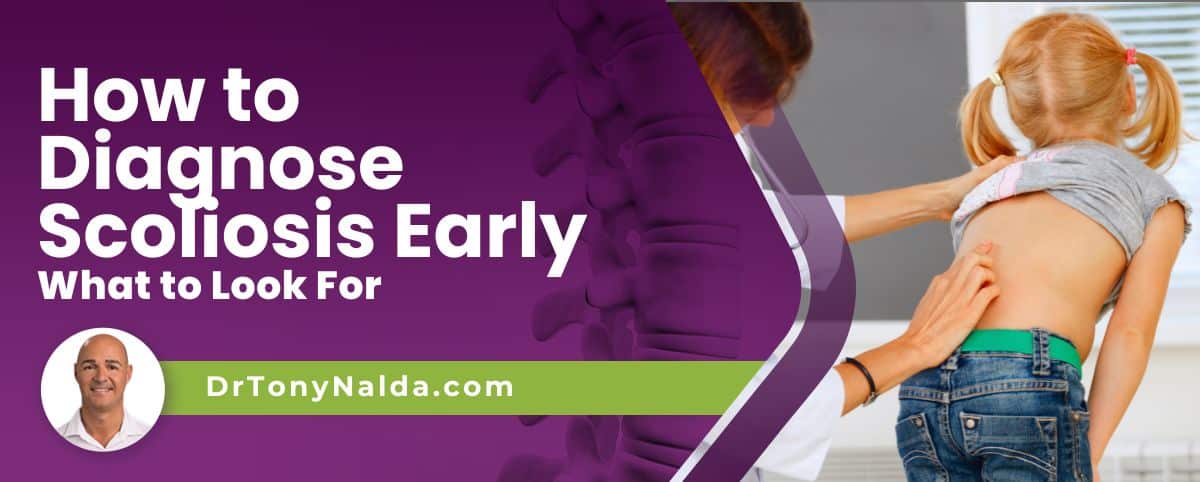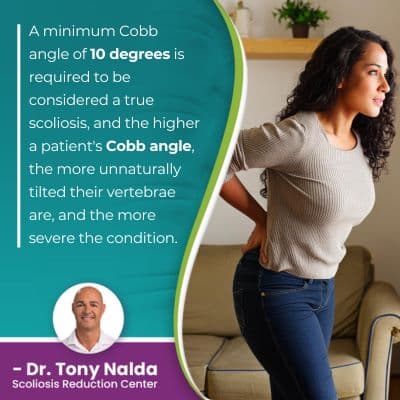How to Diagnose Scoliosis Early: What to Look For

Diagnosing scoliosis also involves further classifying conditions based on key patient/condition variables. Diagnosing scoliosis early has a number of treatment benefits, but results can never be guaranteed. Knowing the condition's early signs to look for can lead to early detection.
Diagnosing scoliosis early means when it's still mild and it's early in the condition's progressive line. Scoliosis ranges from mild to very severe, and what to look for in children are postural changes, and for adults, it's back pain and pain that radiates into the extremities.
Scoliosis isn't always easy to diagnose, so let's start with why.
Table of Contents
Diagnosing Scoliosis
Scoliosis is a highly-prevalent spinal condition with current estimates at close to seven million people living with the condition in the United States alone, and as the leading spinal deformity among school-aged children, awareness is important.
There was a time when scoliosis screening was performed in schools across the States, but that has since changed, shifting the onus of recognizing its early signs onto the shoulders of parents, caregivers, and patients themselves.
Diagnosing scoliosis means an unnatural sideways-bending and rotating spinal curve has developed and is reached through a physical examination that includes taking the patient's family history, medical history, performing an adam's forward bend test, and the results of a scoliosis X-ray.
An X-ray is needed to fully see what's happening in and around the spine, to confirm the rotational component, and the patient's Cobb angle measurement.
Diagnosing scoliosis also means classifying conditions, and this is done to streamline the treatment process and inform the crafting and customization of treatment plans.
Diagnosing Condition Severity
A key condition variable is severity because the more severe a condition, the more noticeable its effects are likely to be, and while all severity levels of scoliosis need treatment, the more severe a condition is, the more likely it is to continue progressing.
The longer scoliosis is left untreated, the more likely it is to develop complications such as lung impairment and digestive issues.
As a progressive condition, where a patient's scoliosis is at the time of diagnosis doesn't mean that's where it will stay.
Scoliosis can be diagnosed as mild scoliosis, moderate scoliosis, severe, or very severe scoliosis, and condition severity is determined by a measurement known as Cobb angle.
 A minimum Cobb angle of 10 degrees is required to be considered a true scoliosis, and the higher a patient's Cobb angle, the more unnaturally tilted their vertebrae are, and the more severe the condition.
A minimum Cobb angle of 10 degrees is required to be considered a true scoliosis, and the higher a patient's Cobb angle, the more unnaturally tilted their vertebrae are, and the more severe the condition.
Cobb angle is determined during X-ray by drawing lines from the bottoms and tops of the vertebrae at the apex of the curve as these are the most tilted, and the resulting angle is expressed in degrees:
- Mild scoliosis: Cobb angle measurement of between 10 and 25 degrees
- Moderate scoliosis: Cobb angle measurement of between 25 and 40 degrees
- Severe scoliosis: Cobb angle of 40+ degrees
- Very-severe scoliosis: Cobb angle measurement of 80+ degrees
In addition to condition severity, condition's are also classified based on patient age, condition type, and curvature location.
Patient Age
Scoliosis affects all ages, but is most common among adolescents as adolescent idiopathic scoliosis, diagnosed between the ages of 10 and 18.
Babies born with scoliosis have congenital scoliosis; infantile scoliosis is diagnosed in infants between the ages of 6 months and 3 years, juvenile scoliosis affects children between the ages of 3 and 10 years old, adolescent idiopathic scoliosis, and adult scoliosis is diagnosed once skeletal maturity has been reached.
Patient age is most important when it comes to progression and pain. We don't always know what causes scoliosis to develop, but we know it's growth that causes it to progress, so childhood scoliosis diagnosed early should be taken very seriously.
Patient age also indicates whether pain is likely to be an issue or not as scoliosis isn't commonly painful for children because it doesn't become a compressive condition until growth has stopped, and then compression of the spine and its surrounding muscles and nerves is the main cause of condition-related pain.
Muscle weakness and pain, back pain, and pain that radiates into the extremities is the main sign of scoliosis in adults that leads to a diagnosis and treatment.
Condition Type
Condition type is determined by its underlying cause, and the most common type of scoliosis diagnosed in all ages is idiopathic scoliosis, and this type is not clearly associated with a single-known cause.
Approximately 80 percent of known diagnosed cases are idiopathic scoliosis, and the remaining 20 percent are associated with known causes: neuromuscular scoliosis, degenerative scoliosis, and congenital scoliosis.
Neuromuscular scoliosis is caused by the presence of a larger neuromuscular condition such as cerebral palsy, muscular dystrophy, and spina bifida.
Degenerative scoliosis affects older adults and is caused by natural age-related spinal degeneration and the cumulative effect of certain lifestyle factors: carrying excess weight, low activity levels, chronic poor posture, etc.
Congenital scoliosis is caused by a malformed spine that develops in utero.
Condition type is important because in order to treat the condition itself, and not just its symptoms, its underlying cause, and structural nature, has to be addressed.
Curvature Location
There are three main sections of the spine: the cervical spine (neck), the thoracic spine (middle/upper back), and the lumbar spine (lower back).
Scoliosis can develop in any one of the spine's main sections, or in more than one as a combined scoliosis, and determining curvature location is an important part of a diagnosis not only so its known where treatment needs to be concentrated, but also because curvature location indicates certain effects.
In most spinal conditions, the area of the body located the closest to the affected spinal section is going to be the most likely to feel its direct effects; for example, with lumbar scoliosis, a common effect is sciatic nerve pain because the sciatic nerve starts in the lower back, and in adults, nerve compression is an issue.
The Early Signs of Scoliosis
The best approach to treating scoliosis is to be proactive; as a progressive condition, the best time to start scoliosis treatment is always now, regardless of type or severity.
In children, the main signs of scoliosis involve postural changes, and in most cases, the earliest signs are uneven shoulders and hips and additional signs can include:
- The head being uncentered over the torso
- Uneven shoulder blades
- Development of a rib cage arch
- An uneven waistline
- Arms and legs that don't hang symmetrically
As scoliosis progresses and becomes more severe, not only does it get more complex to treat, its effects become more noticeable and can include movement: coordination, balance, and gait.
 Knowing the early signs of scoliosis in children can lead to early detection, and while there are never treatment guarantees, early detection, when met with early intervention, is associated with treatment success.
Knowing the early signs of scoliosis in children can lead to early detection, and while there are never treatment guarantees, early detection, when met with early intervention, is associated with treatment success.
In adults, the early signs of scoliosis involve postural changes also, but as adult scoliosis is compressive, the more noticeable sign that brings adults in to see for a diagnosis and treatment is pain, most often pain that radiates into the extremities due to nerve compression.
How Does Early Detection Help With Treatment?
As scoliosis progresses, the size of the unnatural spinal curve is increasing, as are the condition's uneven forces, and their effects.
As scoliosis progresses, the condition is getting more severe and difficult to treat, and this is because the spine gets increasingly rigid alongside progression, making it less responsive to chiropractic treatment and making it difficult for some patients to perform key therapeutic scoliosis exercises as part of treatment.
In most cases, it's more effective to proactively work towards preventing progression than it is to attempt to reverse its effects once established.
A modern conservative scoliosis treatment approach has the goal of preventing progression, increasing condition effects, and the need for invasive spinal fusion surgery in the future.
The reality is that scoliosis can be highly treatable, particularly with early detection and intervention, and many cases of scoliosis don't require surgical treatment; the earlier treatment is started, the less likely it is that scoliosis surgery will be necessary.
Proactive nonsurgical scoliosis treatment combines multiple different types of treatment such as condition-specific chiropractic care, physical therapy, corrective bracing, and rehabilitation, and when treatment is started early, there are fewer limits to what can be achieved with nonsurgical treatment.
Conclusion
Treatment options for scoliosis include a traditional surgical response to a diagnosis, or a modern conservative nonsurgical response, and here at the Scoliosis Reduction Center, nonsurgical treatment is started as close to the time of diagnosis as possible as this is when conditions will be at their mildest and most treatable.
Scoliosis screenings are important and can help lead to early detection, and the first step is knowing the condition's early signs to recognize, and in children, as a child grows, the signs become more overt such as uneven shoulders, shoulder blades, a rib cage arch, and more; in adults, postural changes are common, but one of the most noticeable scoliosis symptoms of adult scoliosis is pain.
As a progressive condition, there is no way to cure scoliosis, but it can be highly treatable, and routine screening can help prevent the need for invasive spinal surgery that involves metal rods attached to the spine, as conditions are treated proactively.
When diagnosed in early adolescence, the focus of treatment is to impact the condition on a structural level through a curvature reduction, increasing core strength through physical therapy and scoliosis exercises, corrective bracing can push the spine into an aligned position, and rehabilitation can work towards further healing and stabilizing the spine.
It's important for scoliosis patients to understand that different approaches to scoliosis treatment can shape long-term spinal health and function differently, and while early detection offers a number of treatment benefits, the benefits are only available to those that respond with a proactive treatment approach: what patients of the Center benefit from.
Dr. Tony Nalda
DOCTOR OF CHIROPRACTIC
After receiving an undergraduate degree in psychology and his Doctorate of Chiropractic from Life University, Dr. Nalda settled in Celebration, Florida and proceeded to build one of Central Florida’s most successful chiropractic clinics.
His experience with patients suffering from scoliosis, and the confusion and frustration they faced, led him to seek a specialty in scoliosis care. In 2006 he completed his Intensive Care Certification from CLEAR Institute, a leading scoliosis educational and certification center.
About Dr. Tony Nalda
 Ready to explore scoliosis treatment? Contact Us Now
Ready to explore scoliosis treatment? Contact Us Now





